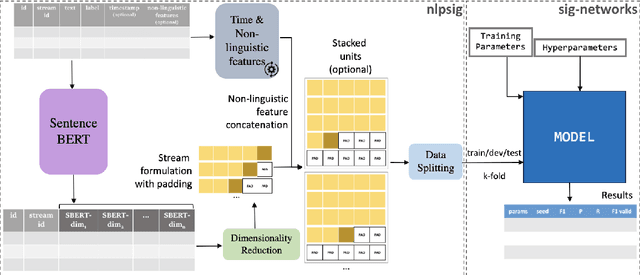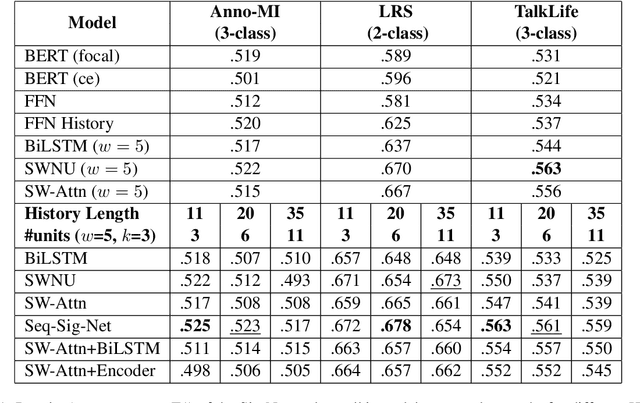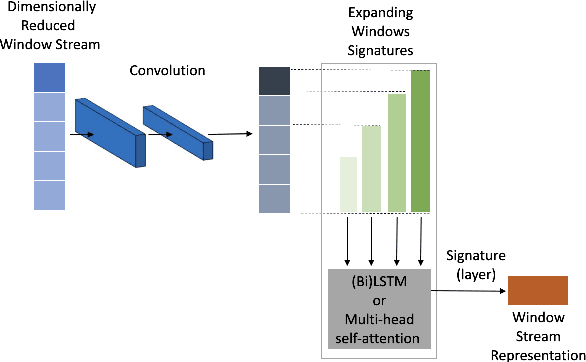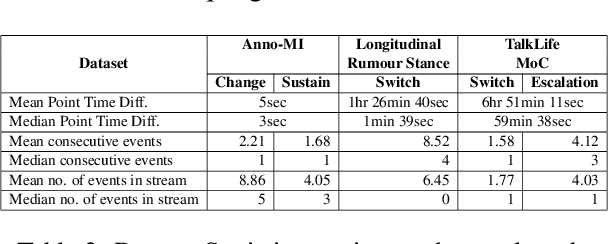Terry Lyons
Structured Linear CDEs: Maximally Expressive and Parallel-in-Time Sequence Models
May 23, 2025Abstract:Structured Linear Controlled Differential Equations (SLiCEs) provide a unifying framework for sequence models with structured, input-dependent state-transition matrices that retain the maximal expressivity of dense matrices whilst being cheaper to compute. The framework encompasses existing architectures, such as input-dependent block-diagonal linear recurrent neural networks and DeltaNet's diagonal-plus-low-rank structure, as well as two novel variants based on sparsity and the Walsh--Hadamard transform. We prove that, unlike the diagonal state-transition matrices of S4 and Mamba, SLiCEs employing block-diagonal, sparse, or Walsh--Hadamard matrices match the maximal expressivity of dense matrices. Empirically, SLiCEs solve the $A_5$ state-tracking benchmark with a single layer, achieve best-in-class length generalisation on regular language tasks among parallel-in-time models, and match the state-of-the-art performance of log neural controlled differential equations on six multivariate time-series classification datasets while cutting the average time per training step by a factor of twenty.
Transforming CCTV cameras into NO$_2$ sensors at city scale for adaptive policymaking
Dec 28, 2024



Abstract:Air pollution in cities, especially NO\textsubscript{2}, is linked to numerous health problems, ranging from mortality to mental health challenges and attention deficits in children. While cities globally have initiated policies to curtail emissions, real-time monitoring remains challenging due to limited environmental sensors and their inconsistent distribution. This gap hinders the creation of adaptive urban policies that respond to the sequence of events and daily activities affecting pollution in cities. Here, we demonstrate how city CCTV cameras can act as a pseudo-NO\textsubscript{2} sensors. Using a predictive graph deep model, we utilised traffic flow from London's cameras in addition to environmental and spatial factors, generating NO\textsubscript{2} predictions from over 133 million frames. Our analysis of London's mobility patterns unveiled critical spatiotemporal connections, showing how specific traffic patterns affect NO\textsubscript{2} levels, sometimes with temporal lags of up to 6 hours. For instance, if trucks only drive at night, their effects on NO\textsubscript{2} levels are most likely to be seen in the morning when people commute. These findings cast doubt on the efficacy of some of the urban policies currently being implemented to reduce pollution. By leveraging existing camera infrastructure and our introduced methods, city planners and policymakers could cost-effectively monitor and mitigate the impact of NO\textsubscript{2} and other pollutants.
Combining Hough Transform and Deep Learning Approaches to Reconstruct ECG Signals From Printouts
Oct 18, 2024Abstract:This work presents our team's (SignalSavants) winning contribution to the 2024 George B. Moody PhysioNet Challenge. The Challenge had two goals: reconstruct ECG signals from printouts and classify them for cardiac diseases. Our focus was the first task. Despite many ECGs being digitally recorded today, paper ECGs remain common throughout the world. Digitising them could help build more diverse datasets and enable automated analyses. However, the presence of varying recording standards and poor image quality requires a data-centric approach for developing robust models that can generalise effectively. Our approach combines the creation of a diverse training set, Hough transform to rotate images, a U-Net based segmentation model to identify individual signals, and mask vectorisation to reconstruct the signals. We assessed the performance of our models using the 10-fold stratified cross-validation (CV) split of 21,799 recordings proposed by the PTB-XL dataset. On the digitisation task, our model achieved an average CV signal-to-noise ratio of 17.02 and an official Challenge score of 12.15 on the hidden set, securing first place in the competition. Our study shows the challenges of building robust, generalisable, digitisation approaches. Such models require large amounts of resources (data, time, and computational power) but have great potential in diversifying the data available.
Deep Signature: Characterization of Large-Scale Molecular Dynamics
Oct 03, 2024Abstract:Understanding protein dynamics are essential for deciphering protein functional mechanisms and developing molecular therapies. However, the complex high-dimensional dynamics and interatomic interactions of biological processes pose significant challenge for existing computational techniques. In this paper, we approach this problem for the first time by introducing Deep Signature, a novel computationally tractable framework that characterizes complex dynamics and interatomic interactions based on their evolving trajectories. Specifically, our approach incorporates soft spectral clustering that locally aggregates cooperative dynamics to reduce the size of the system, as well as signature transform that collects iterated integrals to provide a global characterization of the non-smooth interactive dynamics. Theoretical analysis demonstrates that Deep Signature exhibits several desirable properties, including invariance to translation, near invariance to rotation, equivariance to permutation of atomic coordinates, and invariance under time reparameterization. Furthermore, experimental results on three benchmarks of biological processes verify that our approach can achieve superior performance compared to baseline methods.
A High Order Solver for Signature Kernels
Apr 01, 2024Abstract:Signature kernels are at the core of several machine learning algorithms for analysing multivariate time series. The kernel of two bounded variation paths (such as piecewise linear interpolations of time series data) is typically computed by solving a Goursat problem for a hyperbolic partial differential equation (PDE) in two independent time variables. However, this approach becomes considerably less practical for highly oscillatory input paths, as they have to be resolved at a fine enough scale to accurately recover their signature kernel, resulting in significant time and memory complexities. To mitigate this issue, we first show that the signature kernel of a broader class of paths, known as \emph{smooth rough paths}, also satisfies a PDE, albeit in the form of a system of coupled equations. We then use this result to introduce new algorithms for the numerical approximation of signature kernels. As bounded variation paths (and more generally geometric $p$-rough paths) can be approximated by piecewise smooth rough paths, one can replace the PDE with rapidly varying coefficients in the original Goursat problem by an explicit system of coupled equations with piecewise constant coefficients derived from the first few iterated integrals of the original input paths. While this approach requires solving more equations, they do not require looking back at the complex and fine structure of the initial paths, which significantly reduces the computational complexity associated with the analysis of highly oscillatory time series.
Multimodal deep learning approach to predicting neurological recovery from coma after cardiac arrest
Mar 09, 2024



Abstract:This work showcases our team's (The BEEGees) contributions to the 2023 George B. Moody PhysioNet Challenge. The aim was to predict neurological recovery from coma following cardiac arrest using clinical data and time-series such as multi-channel EEG and ECG signals. Our modelling approach is multimodal, based on two-dimensional spectrogram representations derived from numerous EEG channels, alongside the integration of clinical data and features extracted directly from EEG recordings. Our submitted model achieved a Challenge score of $0.53$ on the hidden test set for predictions made $72$ hours after return of spontaneous circulation. Our study shows the efficacy and limitations of employing transfer learning in medical classification. With regard to prospective implementation, our analysis reveals that the performance of the model is strongly linked to the selection of a decision threshold and exhibits strong variability across data splits.
Theoretical Foundations of Deep Selective State-Space Models
Mar 04, 2024Abstract:Structured state-space models (SSMs) such as S4, stemming from the seminal work of Gu et al., are gaining popularity as effective approaches for modeling sequential data. Deep SSMs demonstrate outstanding performance across a diverse set of domains, at a reduced training and inference cost compared to attention-based transformers. Recent developments show that if the linear recurrence powering SSMs allows for multiplicative interactions between inputs and hidden states (e.g. GateLoop, Mamba, GLA), then the resulting architecture can surpass in both in accuracy and efficiency attention-powered foundation models trained on text, at scales of billion parameters. In this paper, we give theoretical grounding to this recent finding using tools from Rough Path Theory: we show that when random linear recurrences are equipped with simple input-controlled transitions (selectivity mechanism), then the hidden state is provably a low-dimensional projection of a powerful mathematical object called the signature of the input -- capturing non-linear interactions between tokens at distinct timescales. Our theory not only motivates the success of modern selective state-space models such as Mamba but also provides a solid framework to understand the expressive power of future SSM variants.
Log Neural Controlled Differential Equations: The Lie Brackets Make a Difference
Feb 28, 2024Abstract:The vector field of a controlled differential equation (CDE) describes the relationship between a control path and the evolution of a solution path. Neural CDEs (NCDEs) treat time series data as observations from a control path, parameterise a CDE's vector field using a neural network, and use the solution path as a continuously evolving hidden state. As their formulation makes them robust to irregular sampling rates, NCDEs are a powerful approach for modelling real-world data. Building on neural rough differential equations (NRDEs), we introduce Log-NCDEs, a novel and effective method for training NCDEs. The core component of Log-NCDEs is the Log-ODE method, a tool from the study of rough paths for approximating a CDE's solution. On a range of multivariate time series classification benchmarks, Log-NCDEs are shown to achieve a higher average test set accuracy than NCDEs, NRDEs, and two state-of-the-art models, S5 and the linear recurrent unit.
Novelty Detection on Radio Astronomy Data using Signatures
Feb 22, 2024Abstract:We introduce SigNova, a new semi-supervised framework for detecting anomalies in streamed data. While our initial examples focus on detecting radio-frequency interference (RFI) in digitized signals within the field of radio astronomy, it is important to note that SigNova's applicability extends to any type of streamed data. The framework comprises three primary components. Firstly, we use the signature transform to extract a canonical collection of summary statistics from observational sequences. This allows us to represent variable-length visibility samples as finite-dimensional feature vectors. Secondly, each feature vector is assigned a novelty score, calculated as the Mahalanobis distance to its nearest neighbor in an RFI-free training set. By thresholding these scores we identify observation ranges that deviate from the expected behavior of RFI-free visibility samples without relying on stringent distributional assumptions. Thirdly, we integrate this anomaly detector with Pysegments, a segmentation algorithm, to localize consecutive observations contaminated with RFI, if any. This approach provides a compelling alternative to classical windowing techniques commonly used for RFI detection. Importantly, the complexity of our algorithm depends on the RFI pattern rather than on the size of the observation window. We demonstrate how SigNova improves the detection of various types of RFI (e.g., broadband and narrowband) in time-frequency visibility data. We validate our framework on the Murchison Widefield Array (MWA) telescope and simulated data and the Hydrogen Epoch of Reionization Array (HERA).
Sig-Networks Toolkit: Signature Networks for Longitudinal Language Modelling
Dec 06, 2023



Abstract:We present an open-source, pip installable toolkit, Sig-Networks, the first of its kind for longitudinal language modelling. A central focus is the incorporation of Signature-based Neural Network models, which have recently shown success in temporal tasks. We apply and extend published research providing a full suite of signature-based models. Their components can be used as PyTorch building blocks in future architectures. Sig-Networks enables task-agnostic dataset plug-in, seamless pre-processing for sequential data, parameter flexibility, automated tuning across a range of models. We examine signature networks under three different NLP tasks of varying temporal granularity: counselling conversations, rumour stance switch and mood changes in social media threads, showing SOTA performance in all three, and provide guidance for future tasks. We release the Toolkit as a PyTorch package with an introductory video, Git repositories for preprocessing and modelling including sample notebooks on the modeled NLP tasks.
 Add to Chrome
Add to Chrome Add to Firefox
Add to Firefox Add to Edge
Add to Edge